(I´ve been doing a lot of Fibonacci these days.)
What i try to explain is that living organisms have many ordered patterns that appear as well in no animated matter, and the explanation for them has to make room for more concepts than genetics, that do not cope well with interrelational factors. This is how i think about this, biology is narrowing too much its vision of the world to genetics.
Disclaimer:
Symmetries
and patterns appear in many different levels and some of them are not
straightly connected with the survival of the animal. For example the
pattern of rosettes in a felid, that was explained by Alan Turing (the
same Turing of the Enigma machine, by the way). He post the development
of these spots as a reaction-difussion system (in short, models which
explain how the concentration of one or more substances distributed in
space changes under the influence of two processes: local chemical reactions in which the substances are transformed into each other, and diffusion which causes the substances to spread out over a surface in space. http://en.wikipedia.org/w
In fact some types of patterns are very common in living and non-living natural "actors". Spirals appear very frequently in plants, fruits, and dust nebulosas. To physics, spirals are lowest-energy configurations which emerge spontaneously through self-organizing processes in dynamic systems, be it a nebulosa or a plant growing (spirals are hardwired in genes in the case of multiple fruits, but in the case of plants growing, i think they can arrange the distribution of leaves in special cases where the light source is artificially duplicated in a lab test- I may be wrong about this, i haven´t checked it).
There are some different levels in what you can find the occurrence of symmetries.
In fact some types of patterns are very common in living and non-living natural "actors". Spirals appear very frequently in plants, fruits, and dust nebulosas. To physics, spirals are lowest-energy configurations which emerge spontaneously through self-organizing processes in dynamic systems, be it a nebulosa or a plant growing (spirals are hardwired in genes in the case of multiple fruits, but in the case of plants growing, i think they can arrange the distribution of leaves in special cases where the light source is artificially duplicated in a lab test- I may be wrong about this, i haven´t checked it).
There are some different levels in what you can find the occurrence of symmetries.
Symmetry, and by extension the existence of ordered
patterns in organisms, and in nature in general, has always puzzled
naturalists.
As Bill Graham puts it in his blog, patterns in nature , nature is both organized and chaotic, we tend to focus our attention in one side of this equation thus we get surprised by its counterpart, but in the very “nature of Nature” there is room for the two aspects, with a list of organizing principles that is summarized bellow:
As Bill Graham puts it in his blog, patterns in nature , nature is both organized and chaotic, we tend to focus our attention in one side of this equation thus we get surprised by its counterpart, but in the very “nature of Nature” there is room for the two aspects, with a list of organizing principles that is summarized bellow:
- Everything In Nature Is Interconnected
- Nature Is Composed Of Complex Systems
- Nature is Both Ordered And Chaotic
- Energy Is The Operating Currency Of Nature
- Nature’s Systems Are Self Organizing and Emergent
- Nature Systems Are Self Similar
So, I will talk of nature as a interconnection of complex systems, where
the occurrence of ordered patterns is possible.
Patterns in nature are visible regularities of form found in the natural world
These patterns recur in different contexts and can sometimes be modelled mathematically. Natural patterns include symmetries, trees, spirals, meanders, waves, foams, arrays, cracks and stripes.
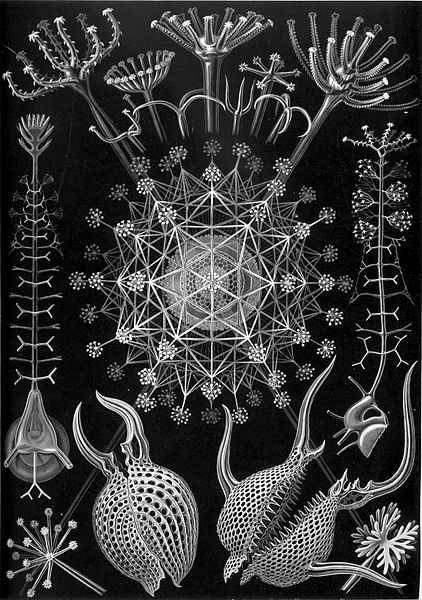 |
| Phaeodaria: Source |
One thing that is really shocking about ordered patterns in nature is that similar designs can appear in living and inerte matter. There have been multiple approachs to the observation of these phenomena and some attemps to explain them although, unlike for gravity attraction -just to give an example-, a simple, unique and universal explanation has never achieved for this. Every case of pattern in nature has a multiple array of causes, and those that are related to living organisms are connected to the need of survival of them. But in general those causes can be connected to two fundamental processes:
- related to development of this pattern,
- and related to preservation of the connected parts that form the pattern (be them parts of a body or parts of a nebulosa).
Examining soap films in the 19th century, Joseph Plateau post the concept of minimal surface ( a surface that locally minimizes its area.). German biologist and artist Ernst Haeckel painted hundreds of marine organisms to emphasise their symmetry, and I want to add that these prints are one of the main reasons why I become interested in existence of patterns in nature.
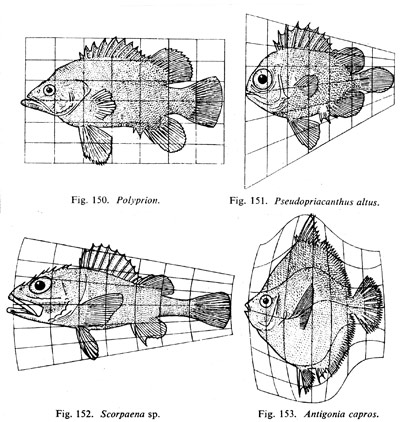 |
| Drawings by D'Arcy Thompson showing relations between body shapes |
In the 20th century, British mathematician Alan Turing predicted mechanisms of morphogenesis which give rise to patterns of spots and stripes (though the bilateral symmetry in them is not so well explained). Aristid Lindenmayer and Benoît Mandelbrot showed how the mathematics of fractals could create plant growth patterns.
I am going to examine two interesting types of patterns, symmetry and spirals.
Symmetry is pervasive in living things, especially in the external form of the body of organisms.
Symmetry can be defined as the property of a body or a physical phenomenon that that is invariant to a transformation, such as reflection but including other transforms too. Spirals are not a proper form of symmetry, but I will add them as a special case where the invariability is observed once dimension is adjusted. It is especially interesting include spirals here as it is one of the pattern more ubiquitous in plants.Animals mainly have bilateral or mirror symmetry, as do the leaves of plants and some flowers such as orchids. Plants often have radial or rotational symmetry, as do many flowers and some groups of animals such as sea anemones. Fivefold symmetry is found in the echinoderms, the group that includes starfish, sea urchins, and sea lilies.
Among non-living things, snowflakes have striking sixfold symmetry: each flake is unique, its structure forming a record of the varying conditions during its crystallisation, with nearly the same pattern of growth on each of its six arms.
Crystals in general have a variety of symmetries and crystal habits; they can be cubic or octahedral, but true crystals cannot have fivefold symmetry (unlike quasicrystals).

Rotational symmetry is found at different scales among non-living things including the crown-shaped splash pattern formed when a drop falls into a pond, and both the spheroidal shape and rings of a planet like Saturn.
The explanation of these symmetries is not given here, but I guess that it has to do with developmental and operative reasons.
Radial symmetry suits organisms like sea anemones whose adults do not move: food and threats may arrive from any direction.
But animals that move in one direction necessarily have upper and lower sides, head and tail ends, and therefore a left and a right. The head becomes specialised with a mouth and sense organs (cephalisation), and the body becomes bilaterally symmetric (though internal organs need not be).
Organs that allow perception use to be duplicated or in even number. The main reason for having them in pairs is to allow a better characterizacion of the environment (a pair of eyes make stereovision possible, and a pair of ears can give the added information of direction of the sound).
More puzzling is the reason for the fivefold (pentaradiate) symmetry of the echinoderms. Early echinoderms were bilaterally symmetrical, as their larvae still are. Sumrall and Wray argue that the loss of the old symmetry had both developmental and ecological causes, which in reality is not saying much, as far as every case of pattern in nature is due to developmental and operative reasons.
The sense of symmetries in living organisms goes far beyond that the
need of survival. It also can be used as a message of beauty and health, or
simply good development, that many others organisms can read and understand.
Symmetry is related to the sense of beauty, and thus with sexual selection;
symmetrical flowers attract more polinizers, etc.
Spirals
Though they are not proper form of symmetry they can regarded as a special occurrence of it, where the regularity of the pattern is noticed changing the size of the elements.
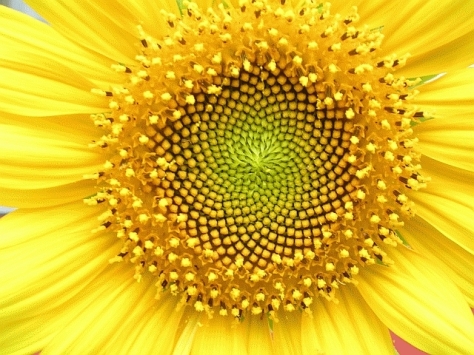
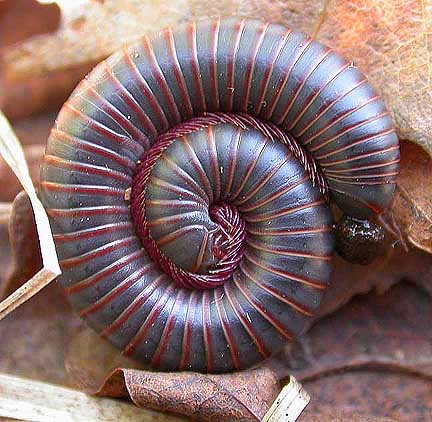
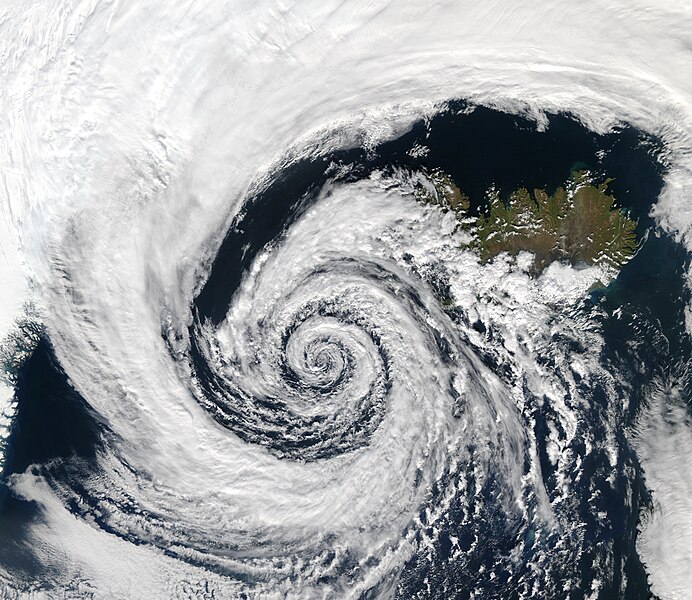
Spirals are common in plants and in some animals, notably molluscs. For example, in the nautilus, a cephalopod mollusc, each chamber of its shell is an approximate copy of the next one, scaled by a constant factor and arranged in a logarithmic spiral. Given a modern understanding of fractals, a growth spiral can be seen as a special case of self-similarity.
Plant spirals can be seen in phyllotaxis, the arrangement of leaves on a stem, and in the arrangement (parastichy) of other parts as in composite flower heads and seed heads like the sunflower or fruit structures like the pineapple and snake fruit, as well as in the pattern of scales in pine cones, where multiple spirals run both clockwise and anticlockwise. These arrangements have explanations at different levels – mathematics, physics, chemistry, biology – each individually correct, but all necessary together. Phyllotaxis spirals can be generated mathematically from Fibonacci ratios: the Fibonacci sequence runs 1, 1, 2, 3, 5, 8, 13... (each subsequent number being the sum of the two preceding ones). For example, when leaves alternate up a stem, one rotation of the spiral touches two leaves, so the pattern or ratio is 1/2. In hazel the ratio is 1/3; in apricot it is 2/5; in pear it is 3/8; in almond it is 5/13. In disc phyllotaxis as in the sunflower and daisy, the florets are arranged in Fermat's spiral with Fibonacci numbering, at least when the flowerhead is mature so all the elements are the same size. Fibonacci ratios approximate the golden angle, 137.508°, which governs the curvature of Fermat's spiral.

